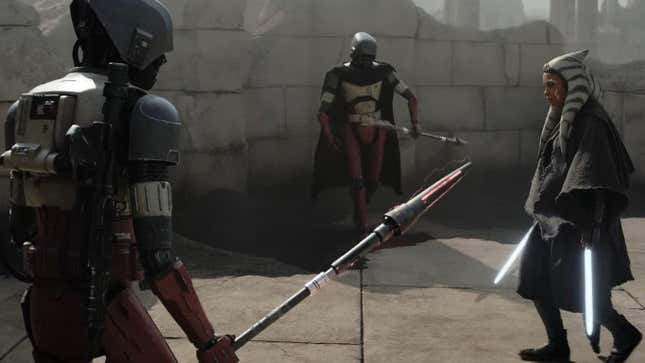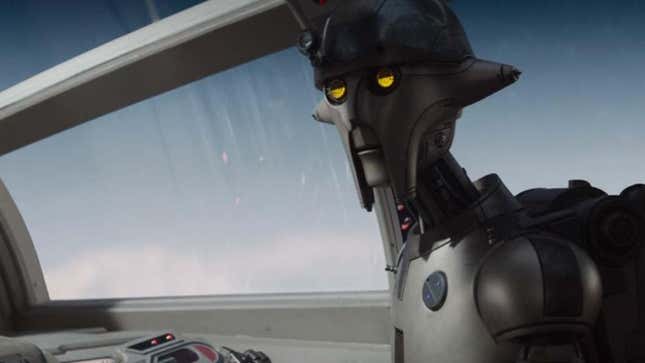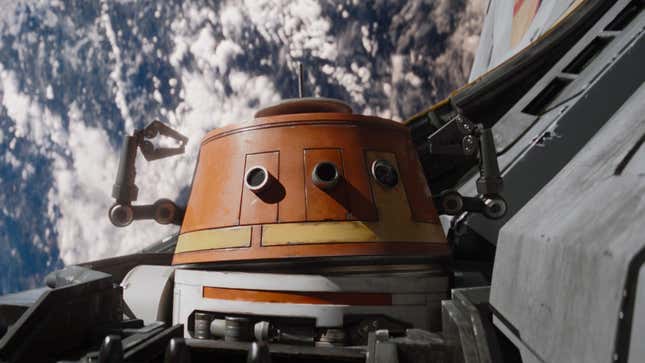Ahsoka is a show that culminates years of effort on the behalf of Lucasfilm to try and build a bridge between the animated work that kept Star Wars going after the movies seemingly came to an end after the prequels, and the live-action television that has sustained it in the modern era. But for all its attempts, its best successes are reminders that sometimes you just need to let characters stay a little animated.
There’s a lot going on in Ahsoka’s first two episodes so far, from map hunts to Jedi duels and all sorts of intrigue, but its biggest questions remain open on just how the series is approaching three of its main protagonists—Ahsoka Tano, Sabine Wren, and Hera Syndulla—and eventually one of its main antagonists, Grand Admiral Thrawn, as they make the transition (in earnest, in Ahsoka’s case) to the realm of live-action Star Wars media. So far it’s not unfair to say there have been a few bumps—an awkward characterization here, a peculiar contact lens there. Although the show is setting the stage for potential when it comes to these characters, we can’t really definitively say one way or the other yet just how successfully Ahsoka will have managed to escape the uncanny valley of trying to take characters you are used to seeing in an animated, stylized exaggeration of the Star Wars galaxy and transposing them into a live-action lens.
Advertisement

But where the series has undoubtedly succeeded in this regard already is in its supporting droid cast: Huyang, David Tennant’s Clone Wars lightsaber archivist; and Chopper, Rebels’ irascible gremlin of an astromech ally. They’re perhaps some of the most fun Star Wars has had with live-action droids since BB-8 changed the game trundling along the sands of Jakku in The Force Awakens’ earliest trailers—and that in part is because they are great adaptations of their animated selves, ones that embrace those roots instead of solely focusing on how live-action Star Wars has handled characters like this in the past.
Advertisement
Advertisement
This is, of course, easier to do with droids than it is human and alien beings like Ahsoka’s main adaptive cast. David Tennant is still charmingly sincere and slightly comedic as Huyang as he was guiding younglings in lightsaber construction in Clone Wars, and Dave Filoni’s chaotic droidspeak is much the same here as it was in Rebels. The uncanny valley is easier to cross when you can largely emulate a character’s aesthetic form in a similar way regardless of the medium like you can with a droid’s design, too, than you can having to put a very real person’s face on a character designed as a stylized being. Huyang and Chopper look like Huyang and Chopper, and they sound like them too. But it’s more than that which creates the fact that they feel like them, too, and it’s something that Ahsoka nails: they’re live action droids but they still move and articulate like their exaggerated animated counterparts.

Most Star Wars droids move a certain way in live-action because of, by and large, the same techniques that have been defining those characters since R2-D2 and C-3PO came on screen at the beginning of A New Hope. They are people in awkward fitting suits that dictate a certain style of character, they are remote controlled vehicles that whir and glide. Even in more contemporary material like the prequels and their Battle Droids, largely VFX creations for the most part, they still move in an attempt to emulate that same kind of style, albeit a little smoother with the benefit of CG technology. Ahsoka still has droids like this too, like the protocol units on Corellia in its second episode, and recent series like Andor and the Mandalorian have largely stuck to these techniques to bring droids like IG-11 or B2EMO to life—certain approaches to droid personhood and personality aside—because, well, that feels like Star Wars. Huyang and Chopper both do this on a base level too, but crucially beyond that, they still move and emote like they did in animation.
There’s a certain specific energy to the way Huyang holds himself that doesn’t feel like a protocol droid or a prequels-era battle droid. He moves a little more smoothly that we’ve come to expect from these physical droids, and there’s an animated exaggeration to him, all the way down to the tiniest details—like the way his eyes aren’t just solid lights, but small screens that allow his pupils to animate and express different emotions. Chopper in particular moves like he does in Rebels down to a tee—even though we’ve not seen much of him outside the co-pilot droid socket in the Phantom, the way his little manipulator arms allow him to comically express his frustrations (and other, slightly less important emotions to Chopper) in episode two are a perfect match.
Advertisement

It makes them both still feel very cartoony, despite being rendered in live-action, and a fascinating foil to how the organic animated characters feel in the show so far. It’s a small detail, but goes a very long way in making the case for at least some of Ahsoka’s leap to live action.
Advertisement
Want more io9 news? Check out when to expect the latest Marvel, Star Wars, and Star Trek releases, what’s next for the DC Universe on film and TV, and everything you need to know about the future of Doctor Who.
Services Marketplace – Listings, Bookings & Reviews